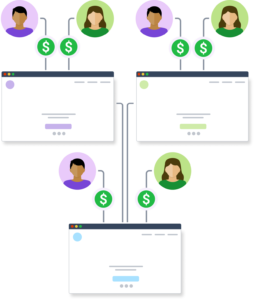3 Best Practices to Elevate Your Peer-to-Peer Fundraising


Did you know that only 14% of peer-to-peer fundraisers become repeat fundraisers for future campaigns? Or that 14% of returning participants can secure up to 3.5 times the contributions of first-time participants?
These two statistics add up to one conclusion: retaining peer-to-peer participants is crucial to maximizing fundraising success, but nonprofits are struggling to do precisely that.
At GoodUnited, we encounter peer-to-peer fundraising through our work, helping nonprofits elevate their Facebook Fundraising strategy. We’ve discovered that retaining supporters through peer-to-peer efforts, such as Facebook fundraisers, isn’t about simply reaching a greater audience, automating your messaging, or using targeted ads.
What drives future participation in your peer-to-peer campaigns is building relationships with each and every fundraising participant, so they continue engaging with your organization again and again.
In this guide, we’re going to cover a few overarching best practices for P2P fundraising and actionable tips to help you raise your relationships with participants. You’ll explore the following best practices:
- Understand who your supporters are and why they support your organization
- Inspire P2P participants with an engaging experience
- Grow your relationships with peer-to-peer supporters
While many of our suggestions will discuss Facebook fundraising tools, understand that these tips can be implemented regardless of the peer-to-peer platform you use. With that, let’s dive in.
Create a Comprehensive Peer-to-Peer Fundraising Communications Plan
Watch this on-demand webinar to learn tips that’ll help ensure your peer-to-peer fundraising campaigns and events run smoothly and get you the best results.
Understand Who Your Supporters Are And Why They Support Your Organization
Some fundraising channels— such as your online donation page or text-to-give efforts— succeed solely through the ease and convenience of the giving process. The difference between a donor giving once, giving a recurring donation, or not giving at all comes down to the platform you use to facilitate the process.
Peer-to-peer fundraising, on the other hand, relies significantly less on the technology you’re using. Peer-to-peer fundraising depends on successful relationship building, and that’s accomplished through the messages and communications you share with each supporter.
The first step to crafting an effective content strategy is to gather insights about your audience. The goal is to understand who your peer-to-peer supporters are, why they’re supporting your organization, and how you can appeal to them further using that information.
With P2P fundraising, we’re talking about two different audiences: participants who start fundraisers and donors who give to those fundraisers. Let’s consider the motivations of both.
Participants who start P2P fundraisers:
- Have a strong emotional connection to your cause, enough to champion it publicly to their friends and family members: In fact, Classy found that 84% of social media users share content to show their support for a cause and highlight important issues. They’re not necessarily connected to your nonprofit itself but your mission.
- Want to make a substantial impact for your cause, perhaps more than they could make individually: A peer-to-peer participant could give directly to your organization, donating an amount that’s financially feasible for them — say, anywhere from $20 to $100. By going out on a limb and soliciting gifts from their networks, that gift can inflate into the hundreds and beyond.
For these supporters, the primary driver is not your organization but your mission. Now, let’s consider the donors to a peer-to-peer fundraiser. These supporters:
- Give in support of their friend, family member, or colleague: For example, if your close family member chose to donate their birthday on Facebook and asked you to contribute, why would you choose to do so? Most likely, it would be to provide your family member with the gift of reaching their fundraising goal.
- Give in support of your mission: In some instances, donors are already familiar with your mission when they’re approached to donate to a peer-to-peer campaign. Even if they’re not super close with the participant, they may choose to give regardless to advance your mission.
With P2P fundraising, you have an excellent opportunity to connect with new donors, impress them with your peer-to-peer campaign, and grow your supporter base through the process. Let’s walk through how you can “wow” fundraisers and donors in the next section.


Reach More Supporters with Keela’s Peer-to-Peer Fundraising Tool
Your supporters can now fundraise with you! Using Keela’s NEW peer-to-peer fundraising tool, supporters can create and share customizable fundraising pages to raise money for your nonprofit’s campaigns.
Inspire P2P Participants With An Engaging Experience
In the introduction, we learned that returning peer-to-peer participants have a more significant impact on your organization’s campaigns than first-time supporters. Let’s draw back to the motivations from the last section — for fundraisers; they return because they want to further your cause.
To encourage them to return over and over again, you need to forge a strong connection between your cause and each individual supporter, showing them that they’re appreciated and their contributions are valuable. This connection will inspire them to return and fundraise again and again.
Here are a few techniques we’ve found to inspire participants during a peer-to-peer fundraiser:
1. Create Online Communities For P2P Fundraisers
When participants engage with one another — rather than fundraising in isolation — they understand that their efforts are part of a grander narrative.
We’ve found that organizations have great success creating Facebook Groups for P2P participants. These individuals can then network with one another, support one another’s fundraisers, and share tips for effective fundraising.
2. Share Encouragement, Tips, And Reminders.
Remember that peer-to-peer participants aren’t professional fundraisers. Along their fundraising journey, share kind notes of encouragement to fuel them to reach their goal. Additionally, share tips to help them maximize their campaigns and raise more.
For example, did you know that 94% of peer-to-peer fundraisers on Facebook that don’t receive their first donation within 24 hours never do? Tell your participants this startling statistic and remind them that making the first donation themselves can set their fundraiser up for success.
3. Invite Peer-to-Peer Supporters To Participate In Unique Virtual Events
Did you know that 41% of non-governmental nonprofits have used Facebook to report live from an event or to showcase their organization’s work? Considering Facebook has tools to accept donations while live streaming, it’s fairly straightforward to hold full virtual events on the platform.
You could hold a walk-a-thon-style event and have participants raise P2P funds leading up to it. On the date of the actual event, participants complete the challenge in unison, and you can even livestream some of your staff doing the same from your headquarters.
Create a Comprehensive Peer-to-Peer Fundraising Communications Plan
Watch this on-demand webinar to learn tips that’ll help ensure your peer-to-peer fundraising campaigns and events run smoothly and get you the best results.
Grow Your Relationships With Peer-to-Peer Supporters
The above ideas will engage and inspire your peer-to-peer participants, increasing the likelihood that they return to fundraise on your behalf again. But, remember that truly successful P2P fundraising isn’t just about getting supporters to fundraise again— but about building strong relationships with those supporters to last a lifetime.
What can you do to build intimacy with each P2P participant, so they’ll support your organization in campaigns and beyond? Engage in one-on-one conversational messaging.
In this GoodUnited guide to virtual peer-to-peer fundraising, we discuss how actively engaging with P2P participants and creating an ongoing partnership between those supporters and your organization is an impactful tool to raise your relationships.
These conversations begin with a “thank you” comment on each Facebook fundraiser that a user starts on your behalf. You can use the “Sort & Filter” tool (found through the Fundraisers view of your nonprofit’s profile) to discover the most recently created campaigns that haven’t been thanked yet.
Consider making this thank-you note two-fold and inviting users to connect with your organization further. For example, share a link to volunteer or event registration opportunities on your website. Or, invite users to stay in contact with your organization through our favorite in-channel communication method: Facebook Messenger.
With Facebook Messenger, you can:
- Maintain one-on-one conversations with each individual user: These communications can be ongoing well beyond the fundraiser itself, keeping the user and your organization connected year-round.
- Personalize your messaging to meet the needs of your supporters: Are they seeking fundraising tips? Encouragement? Links to new opportunities to engage? Just as you would when speaking face-to-face, you can share that information via Messenger.
- Learn more about your social media supporters: Share surveys and one-off questions to understand why individuals take action on behalf of your organization and how you can motivate them to continue doing so.
With Messenger, you can chat with the next generation of your supporters as individuals. Rather than broadcasting wide-ranging posts, you can build intimacy with each one of your P2P participants for relationships that last.
Reach More Supporters with Keela’s Peer-to-Peer Tool
Get a glimpse of how Keela’s P2P tool allows your supporters to create and share customizable fundraising pages to raise more for your campaigns.
Wrapping Up
While peer-to-peer fundraising is often heralded as an effective tool for expanding to new audiences, the fact is that many nonprofits fail to capture these new one-time supporters and inspire them into impactful, long-term support.
At GoodUnited, we’ve found that improving your understanding of peer-to-peer supporters, inspiring them with impactful experiences, and growing your relationships with them through intentional communications is key to capturing new supporters and maximizing your long-term fundraising strategies. With these tips, you’ll be off to a great start — and you can level up your strategy even further with the help of a company that provides managed services for social media fundraising. Good luck!


About the Author:
Maria Clark, Executive Vice President, Partnerships, and Chief Evangelist at GoodUnited
Maria Clark is a nonprofit executive and technology evangelist with 30+ years of industry experience. Today she serves as Executive Vice President of Partnerships and Chief Evangelist for GoodUnited, the social fundraising solution. Maria is a champion of the new and has fearlessly led change management efforts throughout her career.
Previously, Maria spent 33 years at the American Cancer Society, a top #20 US nonprofit and the leading cancer research nonprofit with an annual $800+M budget, in roles spanning all aspects of nonprofit communication, operations, and fundraising. Most recently, as Senior Vice President for Peer to Peer Development, Maria led strategy development, planning, and implementation for name brand ACS events like Relay for Life, Making Strides Against Breast Cancer, a robust gala and golf portfolio, and the Raise Your Way DIY platform, as well as championing new digital strategies that support community fundraising.
Maria lives with her husband Derek in Dallas, Texas, where she has a deep history with the nonprofit community. She serves on the Board of Directors for the Notre Dame School, a special needs Kindergarten through post high school in Dallas, and remains active in the Leadership Dallas Alumni Association. Maria is mom to two adult daughters, Devin and Corrie and her fur baby, Ozzy.





